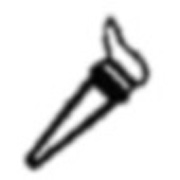







Mint and Privy Marks
To date, and with the exception of the 1976 prestige issue, all coins minted on behalf of monetary authorities in the Comoros have been minted in France. The 1990 50 franc coin apart, all these coins therefore bear French mint and privy marks as described below.
|
|
Mint mark A, left, is the mark used in the nineteenth century by the Monnaie de Paris mint to distinguish the coins struck at Paris from those struck elsewhere. It is a letter "A". Other mint marks in use in France in the nineteenth century included "BB" (Strasbourg), "D" (Lyons) and "MA" (Marseilles). In 1880 the Monnaie de Paris became the only mint authorised to mint coins in France. As a result the "A" mint mark became redundant and it was replaced by the "Horn of Plenty" privy mark (see below). So why is there an "A" mint mark in addition to the "Horn of Plenty" on the coins minted for Said Ali? Force of habit seems to be the reason: it wasn't until 1895 that French coins ceased to bear the Paris "A" mint mark and during this fifteen year transition period coins often had both. The reason why the mark still appears on the coins minted in 1901 involves the way the coins are engraved: removing the mark would have involved re-engraving the entire coin. |
 |
Once other mints in France ceased minting coins and all coins issued from the Monnaie de Paris mint, the "A" mint mark became redundant as an identifier. Since it was still desirable to have some sort of indication on the coin of which mint had struck it, the "Horn of Plenty" mint mark was chosen to replace it. It has appeared, and to this day continues to appear on all coins struck at the Monnaie de Paris unless there are specific reasons for it to be omitted (see the 1990 50 francs issue) |
 |
Most coins bear some indication of the engraver's identity. The Said Ali coins were in fact engraved by Henri Auguste Patey, engraver at the Monnaie de Paris mint. However, the privy mark on the 1889 issue is that of the chief engraver at the mint, for it was he who was ultimately responsible for the coins emanating from his workshop. Each chief engraver chose his own privy mark, and the "fasces" mark at C on these coins is that of Jean Lagrange, chief engraver from 1880 to 1896. |
 |
The only difference between the coins struck for Said Ali in 1889 and those struck in 1901 was the change in privy mark to reflect the fact that the mint now had a new chief engraver. This new "torch" privy mark was that of Lagrange's successor, Patey himself, who also engraved the coin. |
 |
By the time the coins of 1964 were minted the chief engraver had changed identity several times. In October 1958, Raymond Joly was named to the office, and he chose as his symbol the owl seen here. He remained chief engraver until April, 1974, and his privy mark is thus on all the coins of the 1964 issue. |
 |
In April of 1974 Emile Rousseau replaced Raymond Joly as chief engraver. His privy mark, a dolphin, was to appear on coins of the independent Comoro Islands for twenty years. He retired in 1994. |
 |
Pierre Rodier replaced Emile Rousseau in February 1994. His privy mark was a bee, a potent symbol of the French monarchy that dates back to the reign of the Merovingian king, Clovis I. |
 |
Gerard Bucquoy replaced Pierre Rodier in February 2000. His privy mark was the horseshoe. |
 |
Serge Levet is the present chief engraver at the Monnaie de Paris. He replaced Gerard Bucquoy in 2003 and his privy mark is the heart. |
|
|
SAID ALI |
|
|
|
|
|
|
|
|